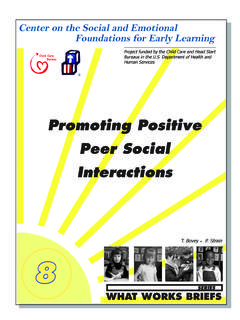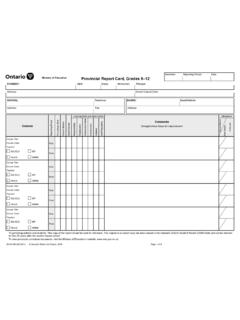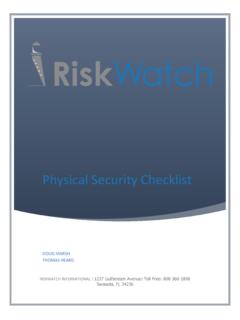Transcription of Guidance to increase physical activity among ... - GOV.UK
1 What works in schools and colleges to increase physical activity ? A resource for head teachers, college principals, staff working in education settings, school nurses, directors of public health, Active Partnerships and wider partners. Guidance to increase physical activity among children and young people in schools and colleges 2 About Public Health England Public Health England exists to protect and improve the nation s health and wellbeing, and reduce health inequalities. We do this through world-leading science, research, knowledge and intelligence, advocacy, partnerships and the delivery of specialist public health services. We are an executive agency of the Department of Health and Social Care, and a distinct delivery organisation with operational autonomy. We provide government, local government, the NHS, Parliament, industry and the public with evidence-based professional, scientific and delivery expertise and support.
2 Public Health England Wellington House 133-155 Waterloo Road London SE1 8UG Tel: 020 7654 8000 Twitter: @PHE_uk Facebook: Prepared by: Debbie Arrigon For queries relating to this document, please contact: Crown copyright 2020 You may re-use this information (excluding logos) free of charge in any format or medium, under the terms of the Open Government Licence To view this licence, visit OGL or email Where we have identified any third party copyright information you will need to obtain permission from the copyright holders concerned. Published March 2020 PHE publications PHE supports the UN gateway number: GW-1195 Sustainable Development Goals Guidance to increase physical activity among children and young people in schools and colleges 3 Contents Foreword 4 Executive summary 6 The purpose of this document 8 Introduction 9 Overview of the benefits for children and young people of physical activity 11 The link between physical activity and academic performance 12 National physical activity guidelines and current participation levels of children and young people 13 Tackling Health Inequalities: under-represented groups 16 physical activity .
3 Policy context 19 The contribution of schools and colleges to increasing physical activity among children and young people 21 Evidence of what works in schools and colleges to increase levels of physical activity and decrease levels of inactivity 25 Principle 1: Deliver multi-component interventions 27 Principle 2: Ensure a skilled workforce 33 Principle 3: Engage student voice 38 Principle 4: Create active environments 42 Principle 5: Offer choice and variety 50 Principle 6: Embed in curriculum, teaching and learning 55 Principle 7: Promote active travel 61 Principle 8: Embed monitoring and evaluation 65 Signposting 72 Appendix 1: Methodology 83 Appendix 2: Feedback from young people 86 Appendix 3: The role of national and local government 93 Appendix 4: Glossary 96 References 97 Guidance to increase physical activity among children and young people in schools and colleges 4 Foreword physical activity contributes to both good physical and mental development.
4 It has a wide range of physical and emotional benefits, from developing muscle and bone strength, increasing concentration and educational performance and learning, to boosting mood and reducing the risk of many lifestyle related diseases. Developing regular physical activity behaviours in childhood is crucial as we know that children who are active are more likely to become active adults and continue to reap the benefits of an active lifestyle throughout their life course. However, too many children and young people are not reaching the recommended levels of physical activity . This is a particular issue for children and young people from black and minority ethnic communities, teenage girls, those with disabilities and children from a lower socio-economic group. Lack of physical activity can contribute to childhood obesity, which has been described as one of the most serious public health challenges in the 21st Century.
5 Currently in England more than 1 in 5 children are overweight or obese when they begin school, with that rising to 1 in 3 children by the time they leave primary school. It is the ambition of this Government to halve childhood obesity rates by 2030 and significantly reduce the health inequalities that persist as outlined in Childhood Obesity: a plan for action and reinforced in chapter two. Getting the nation moving every day is essential. We know that there is a strong link between attainment and educational outcomes and the health and wellbeing of pupils. At a personal level it s fun and sociable and helps people stay physically and mentally well. Schools and colleges play a pivotal role in helping to develop positive physical activity habits by raising awareness of the importance of regular physical activity and by increasing children s exposure to fun and varied activities, as well creating more active environments so that pupils find it easier to simply move more during their day.
6 Importantly, schools and colleges, through both universal and targeted interventions, are uniquely placed to support the most inactive pupils, as well as the wider school community, to become more active. Personal, Social and Health Education (PSHE) is essential, however there are educational benefits associated with physical activity beyond PSHE for schools and colleges, such as educational attainment, concentration and social cohesion, contributing to a healthier and happier school or college. Guidance to increase physical activity among children and young people in schools and colleges 5 About this resource This report was originally prepared by: The Youth Sport Trust (YST), Association of Colleges Sport (AoC Sport) and Public Health England (PHE) in 2015 with valuable contributions from colleagues working across education, health, transport, sport, local and national government, academic and the voluntary, community and social enterprise sectors.
7 Prepared by Public Health England, the Youth Sport Trust and AoC Sport and supported by the Department of Health and Social Care; the Department for Transport; the Department for Culture, Media the Department for Education and Sport England. The document was updated in 2019 by PHE. Thanks are extended to Tatiana de Berg and Anne Pridgeon, working with the Children, Young People and Families team. Guidance to increase physical activity among children and young people in schools and colleges 6 Executive summary Promoting the health and wellbeing of pupils and students within schools and colleges has the potential to improve both educational and health and wellbeing outcomes. This resource brings together key Guidance and policy documents on increasing physical activity alongside local examples, which has been produced to support schools and colleges, develop and implement effective evidence-based approaches utilising 8 key principles.
8 The 8 key principles are: 1. Develop and deliver multi-component interventions adopting a whole of community (school/college) approach appears to be most effective for increasing physical activity : incorporating curricular learning with the culture, ethos and environment and engagement of the wider school community. 2. Ensure skilled workforce - ensuring staff have the confidence and competence to offer high quality experiences of both physical education and physical activity across the school/college day. 3. Engage student voice - giving students a voice and enhancing their ownership of physical activity delivery to ensure that activities are appropriately tailored to their needs can support participation. Guidance to increase physical activity among children and young people in schools and colleges 7 4.
9 Create active environments good access to, and integration in the school/college day of, open space, forests, parks and playgrounds are positively associated with physical activity levels. Access to a range of equipment, along with non-traditional play materials also support physical activity among children and young people. 5. Offer choice and variety offering a variety of physical activity opportunities for young people to take part in, including free play can increase participation in physical activity . In addition, a focus on games and fun, as well as the more traditional sports or competitive activities, can help to encourage participation, particularly among inactive pupils. 6. Embed in curriculum, teaching and learning - increasing the amount of time spent being physically active during PE and other lessons can improve both physical development, educational outcomes and emotional development.
10 7. Promote active travel - active travel can play a key role in contributing to children and young people s physical activity levels. Travel plans which include a range of active travel options, have been found to increase physical activity levels among children and young people. 8. Embed monitoring and evaluation - effective evaluation of physical activity interventions is considered to be a cross cutting principle that requires the identification of baseline information, interim outputs or milestones and outcomes. We thank every school and college who has supported this publication. Guidance to increase physical activity among children and young people in schools and colleges 8 The purpose of this document This briefing provides an overview from the evidence base about what works in schools and colleges to increase levels of physical activity amongst children and young people.



















